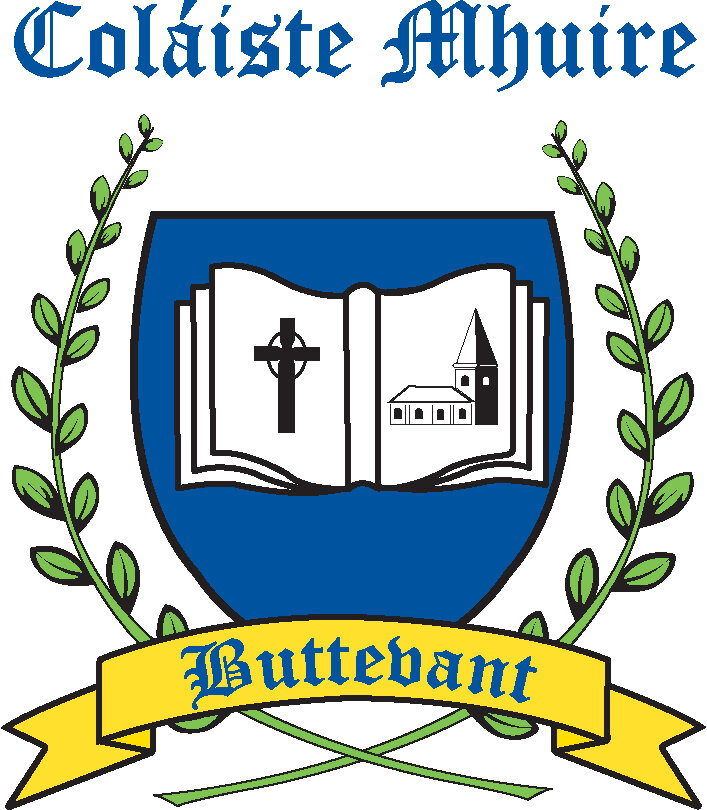Assessment and Reporting on Student’s Learning at Junior Cycle
COLÁISTE MHUIRE, BUTTEVANT
ASSESSMENT AND REPORTING ON STUDENTS’ LEARNING AT JUNIOR CYCLE
MAY 2020
Context
• Students in Irish schools completing their third year of Junior Cycle in 2020 have experienced a very disrupted period of learning in 2019/20 because of the unprecedented nature of the Covid-19 crisis.
• In these circumstances, The Department of Education & Skills (DES) has determined it is not possible for students to undertake the Junior Cycle final examinations normally organised by the State Examinations Commission.
• The following set out alternative arrangements for the assessment and reporting on the learning achievements of Coláiste Mhuire students who are concluding Junior Cycle in May 2020. The following approaches follow guidelines set out for schools by the DES.
Key elements
This year, the learning achievement of students will be recognised through a specific form of certification designed to meet the current, exceptional circumstances presented by the COVID-19 pandemic.
For each student, certification will involve TWO elements:
(1) A State Certificate of completion of Junior Cycle from the Department of Education and Skills. Students should receive a State Certification that they have completed three years of Junior Cycle education in a number of subjects. This certification will be provided by the Department of Education and Skills in Autumn.
(2) A School Report setting out the learning achievements of students over 2nd and 3rd Year. Students will receive a written report on the broad range of learning that they have achieved in each subject and short course. This assessment of their learning will be provided by their subject teachers. Similar to our normal school based summer reports each subject will give (a) a grade, (b) a teacher comment and (c) CBA descriptors where applicable. This is a school based report similar to other term reports and not designed to replace the traditional Junior Certificate/ JCPA.
Coláiste’s assessment of students’ learning achievements
In line with DES guidelines, to determine a grade which is a genuine reflection of the students’ level over the two year period, our teachers will use a range of existing evidence to inform their assessment of students’ achievements. These include: Evidence available from assignments, tests, projects, practical and other work completed over the course of second year and third year. Combined with this, each teacher will allocate some marks for an element or elements of work submitted between now and May 29th. Teachers will inform students what this work is.
In general subject departments and teachers will use either Assessment Model 1 or Model 2 from below depending on the nature of the subject. These models are designed to be somewhat reflective of the marking system used in the Junior Cycle. A minority of subjects have adjusted the weightings slightly to best fit that subject – see below
Model 1
Non practical subjects – subject with no practical component
90% allocated towards an average of reported VS ware assessments and Pre exams over course of 2nd and 3rd Yr. Assessments generally used in calculations 2nd Yr Christmas, 2nd Yr Summer, 3rd Yr Christmas & Pre-Examinations given the following weightings 20%, 20%, 20%, 30% (Pre). The past assessments used may vary slightly depending on the subject. (Where a student missed a written assessment an average of the other assessments will be used. Alternatively, a teacher can decide to use another mid-term assessment where relevant )
10% for some element/elements of course work submitted between now (May 1st) and May 29th. Alternatively a small online assessment.
Model 2
Practical Subjects – subjects with practical components
60% allocated towards an average of practical/project work grades over 2nd and 3rd Yr.
30% allocated towards an average of reported written exams (Pre written Exam + other written exams where applicable) over the two year period.(where a student missed a written assessment an average of the other assessments can be used. )
10% for some element/elements of course work submitted between now (May 1st) and May 29th. Alternatively a small online assessment.
Other Variations
Home Economics - Adapted to suit subject
80% allocated towards an average of reported VS ware assessments and Pre exams over course of 2nd and 3rd Yr. Assessments used in calculations 2nd Yr Christmas, 2nd Yr Summer, 3rd Yr Christmas & Pre-Examinations given the following weightings 10% 20%, 20%, 30% (Pre).
(where a student missed a written assessment an average of the other assessments can be used. )
10% cushion designed and made for Junior Cycle
10% for some element/elements of course work submitted between now (May 1st) and May 29th. Alternatively a small online assessment.
Music - Adapted to suit subject
60% allocated towards an average of reported VS ware assessments and Pre exams over course of 2nd and 3rd Yr. Assessments used in calculations 2nd Yr Christmas, 2nd Yr Summer, 3rd Yr Christmas & Pre-Examinations given the following weightings 10% 10%, 10%, 30% (Pre).
(where a student missed a written assessment an average of the other assessments can be used )
30% for practical music
10% for some element/elements of course work submitted between now (May 1st) and May 29th. Alternatively a small online assessment.
Art – A comprehensive marking scheme is designed and will be forwarded to all students by Ms Garvey – Many components of existing work are being taken into consideration.
Wellbeing Subjects
SPHE - Assessment will consist of Teacher Reflective Comment and CBA Descriptor
CSPE - Assessment will consist of Teacher Reflective Comment and CBA Descriptor
PE - Assessment will consist of Teacher Reflective Comment only


